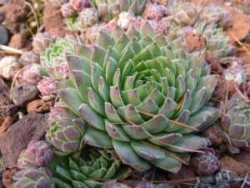My top ten succulent plants for landscaping
Hardy succulents are classed as those that can withstand frost and cold winters, sometimes extreme cold. This list of the 10 Best Hardy Succulents for Landscaping is geared towards those gardeners in Zone 3 to Zone 7 (Canadian Plant Hardiness Zone map) or thereabouts.

In some cases, although these hardy garden plants will grow successfully in warmer zones, they thrive in areas with good snow cover for a winter rest period.
I can recommend these plants for cold climate gardens because they’ve been trialed in my Zone 4A (USDA) xeriscaping, so I can vouch for them from personal experience.
Keep in mind that soil type and usual rainfall in your area will vary, so as with any new plant, trialing under your conditions is recommended.
They will also take several seasons to get established; once their roots reach down into the soil, they will be more drought tolerant as time goes on.
Here are the plants, and a bit about each one – click on the links to see more detail;

Sedum spectabile ‘Autumn Joy’ is a classic xeriscape plant.
Combined with other hardy garden perennials like Rudbeckia and ornamental grasses, this plant gained fame and notoriety as one of the foundation plants for the New American landscape style.
Depending on the soil conditions, temperature and other factors the flowers can range from pale pink to salmon.

Sempervivum, or Hens and Chicks, are not just Granmas favorite old fashioned cottage garden plant any more; their beauty and texture and incredibly wide variation in sizes, growth habit and their toughness has created a new buzz about these plants.
For a textural ground cover, rockery carpet plant, green roof or xeriscape plant they are unsurpassed.

Sedum spurium ‘Dragon’s Blood’, along with closely related plants such as S. s. ‘Fireglow’ and ‘Voodoo’ are staples in the gardening world.
I doubt there is anyone that hasn’t either grown these plants, or wondered at their tough and reliable beauty, as well as their magnetic attraction for butterflies and other pollinating insects.
For a full sun site with perfectly draining (read really poor and gravelly) soil, these are a backbone plant that no xeriscape should be without.

Jovibarba species are not a well known plant; but they should be.
These iron tough little plants survive cold temperatures, extended drought, heat and really poor soil conditions (anything except waterlogged) with equanimity;
they don’t care about where you plant them, if they don’t like it, they’ll produce a clutch of chicks which will roll away to a better place to form a new colony.
These species are so closely related that they commonly interbreed, forming a complex only known as ‘small rosette species’; they’re derived from Jovibarba allionii, sobolifera and others.

Sedum telephium ‘Purple Emperor’ is one of the darkest colored of all the taller border Stonecrop. Majestic, pompous and regal, this is a great plant for the back of a border, where it can provide a backdrop for smaller plants in front.
Even though, in my view, the flowers don’t stand up as well as some of the spectabile varieties, this plant is worth growing just for the unusual color.

Another less well known hardy succulent is Jovibarba heuffelii; sometimes called Sempervivum heuffelii, this is one of those hard to classify plants; I only know that I can’t kill it.
I’ve grown it in some of the worst possible conditions, and sometimes
it shrinks down to almost nothing during a drought, only to spring back undaunted after a drink.

Sedum reflexum ‘Angelina’ – every garden should have at least one golden plant, to add a foil for all the greens and greys in a xeriscape garden.
Angelina stonecrop plays this role in my xeriscaping.
Shy to flower, this plant nevertheless contributes a great splash of bronze, golden orange or lime green, depending on the temperature.

For a completely unusual and different hardy succulent, Orostachys is becoming more commonly grown.
Known to be somewhat slow to get going, and also reluctant unless conditions are perfectly right, this plant should be grown more often in landscaping.
Once the soil conditions are to its liking, this extremely hardy plant survives drought and cold, even growing under the snow.

Sedum ussuriense ‘Turkish Delight’ is a mid sized stonecrop, halfway between the lower growing ground covering types and the upright border Sedum.
I recommend this beautiful pink flowered variety planted in groups and swathes, so you get the full intensity of the dark purple foliage.

Many other Sedum spurium varieties are commonly found in nurseries and garden center, for good reason.
As if their pretty star shaped flowers held above lobed foliage wasn’t enough, the butterflies they’ll attract adds a
whole other dimension to your landscaping. For a low maintenance option that just keeps on giving, Sedum spurium ‘John Creech’ and S. s. green form are good choices.
Other great Sedum plant species and varieties can be seen here.
I’ve had so much fun growing all of these plants; if you haven’t started yet, find them at Amazon; find your hardy succulents here.
You might like these
Rare Hardy Succulents; the uncommon and unusual sought-after specialty plants; tough and beautiful…
Sedum matrona is as the name suggests, rather motherly and robust; the unusual tone of the foliage combines well with other hardy succulents with Matrona as a sturdy and robust backbone…
Grow the Hardy Succulents that I recommend in your garden; you’ll be amazed at their toughness, and beauty…

